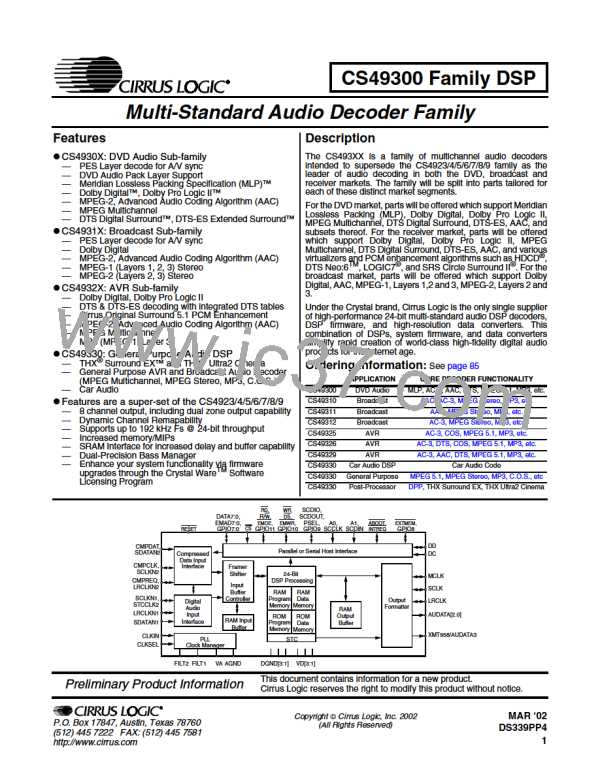CS49300 Family DSP
In autoboot mode, latching the most significant
byte would be perfectly valid since the most
significant bits are guaranteed to be zeros (the three
bytes represent a true 24-bit address).
Hardware configuration messages are used to
define the behavior of the DSP’s audio ports. A
more detailed description of the different hardware
configurations can be found in Section 11,
“Hardware Configuration” on page 72.
The flow chart given in Figure 36, "Autoboot
Sequence" on page 58 demonstrates the interaction The software configuration messages are specific
required by the microcontroller when placing the
DSP into autoboot mode. The host must first drive
the RESET line low.
to each application. The software user’s guides
(AN163, AN163x, AN162, AN162x) for each
application code provides a list of all pertinent
configuration messages. Writing the KICKSTART
message to the CS493XX begins the audio decode
process. The KICKSTART message will also be
described in the user’s guide for each application.
Until the KICKSTART has been sent, the decoder
is in a wait state.
After waiting for 175 ms, the application code
should be fully downloaded to the DSP, however
the designer should note that this time is typical and
may vary for each application code. During the
wait period, the host should ignore all INTREQ
behavior (mask the INTREQ interrupt). The host
can then verify that the code has successfully
initialized itself by sending a solicited read
command to the DSP to check for a known default
8.2.1. Autoboot INTREQ Behavior
It is important to note that ABOOT and INTREQ
are multiplexed on pin 20 of the CS493XX.
Because this pin serves as an input before reset, and
an output after reset, the host should release the
ABOOT line after RESET has gone high. As
shown in Figure 37, "Autoboot INTREQ
Behavior" on page 57, the host must drive ABOOT
low around the rising edge of RESET.
value.
For
example,
by
sending
Rd_Audio_Mgr_Request (0x090003) the host will
receive Rd_Audio_Mgr_Response (0x890003,
0x000000). If the first read attempt returns an
incorrect value, a 5ms wait should be inserted and
the read should be repeated. If a second invalid
response is read, the entire boot process should
then be repeated. When the number returned
matches the default value for the variable read, the
host can be confident that the application is resident
in the DSP and awaiting further instructions. An
application code user’s guide should be consulted
for information about reading a variable from the
part.
After the host has released the ABOOT line, it will
remain high while the DSP prepares to load code
from the external memory. INTREQ should be
ignored during download, i.e. interrupts should be
masked on the host. The download time will vary
according to the size of the download image and
the frequency of the main DSP clock. The autoboot
sequence is specified to complete within 200 ms
Driven Low by Host
Trstsu
Driven Low by CS492X
RESET
Download in Progress
ABOOT
Trsthld
Figure 37. Autoboot INTREQ Behavior
DS339PP4
57

 CIRRUS [ CIRRUS LOGIC ]
CIRRUS [ CIRRUS LOGIC ]